
How to plan a successful HR Strategy Offsite
I’ve run 20+ Strategy Offsites. Over time, you see the patterns of what works and what doesn’t. This post outlines best practices to prepare and execute a great meeting.

Written by
Joris Luijke, Co-Founder & Co-CEO
It may be one of the few times in the year to have the whole HR leadership team together: the annual HR Strategy Offsite.
The HR Strategy Offsite is a meeting with members of your People Team that specifically focuses on creating your strategic plans. It’s generally in-person and takes place outside the office. The goal of the HR Strategy Offsite is to align on the direction & priorities for the HR function.
This may be the most important series of meetings that the Head of HR is responsible for designing and running.
I’ve run about 20+ offsites in my career and attended plenty more. Over time, you start to see patterns of what works and what doesn’t. This post outlines best practices Heads of People can use to make the most of this annual opportunity.
One important note: your entire HR strategy offsite makes or breaks by what happens before you kick off the meetings in the first place.
This blogpost walks through the steps to planning this annual event. To make sure your strategy offsite gets you tangible results you need to answer the following questions:
- First, answer the most basic questions: Who should be there?
- Second, talk about the desired outcomes and the what, when, and why?
- Third, gather the right context, assign pre-work and distribute relevant data.
- Fourth, create a structure for the meeting that will compel progress.
Then I cover suggested activities on the day of your offsite and recommendations on how to wrap-up the day and follow-up after.
Webinar Replay

If you’re running an offsite soon, I strongly recommend you watch this replay of our webinar. The presenters have probably run a combined 40+ offsites:
- Dipti Salopek ran HR at Snyk, Etsy and Criteo before launching her own coaching business.
- Noah Warden runs People at Guusto and was a Cofounder and COO of Battlesnake, prior.
- I, Joris Luijke, ran HR at companies like Atlassian and Squarespace before cofounding Pyn.
1. Who should be at your HR offsite?
I used to feel bad about not inviting everyone. But I ended up feeling worse when I invited too many people. I found there is an ideal size to ensure the conversations are deep enough to make impactful decisions.
I wouldn’t have a group larger than 12 people (and even that is pushing it). This group can go deep on a few topics and get to decisions.
Having said that, the offsite can have a slightly different focus - and different meeting formats to get more people involved at different stages.
There are different offsites for different group sizes for a slightly different purpose:
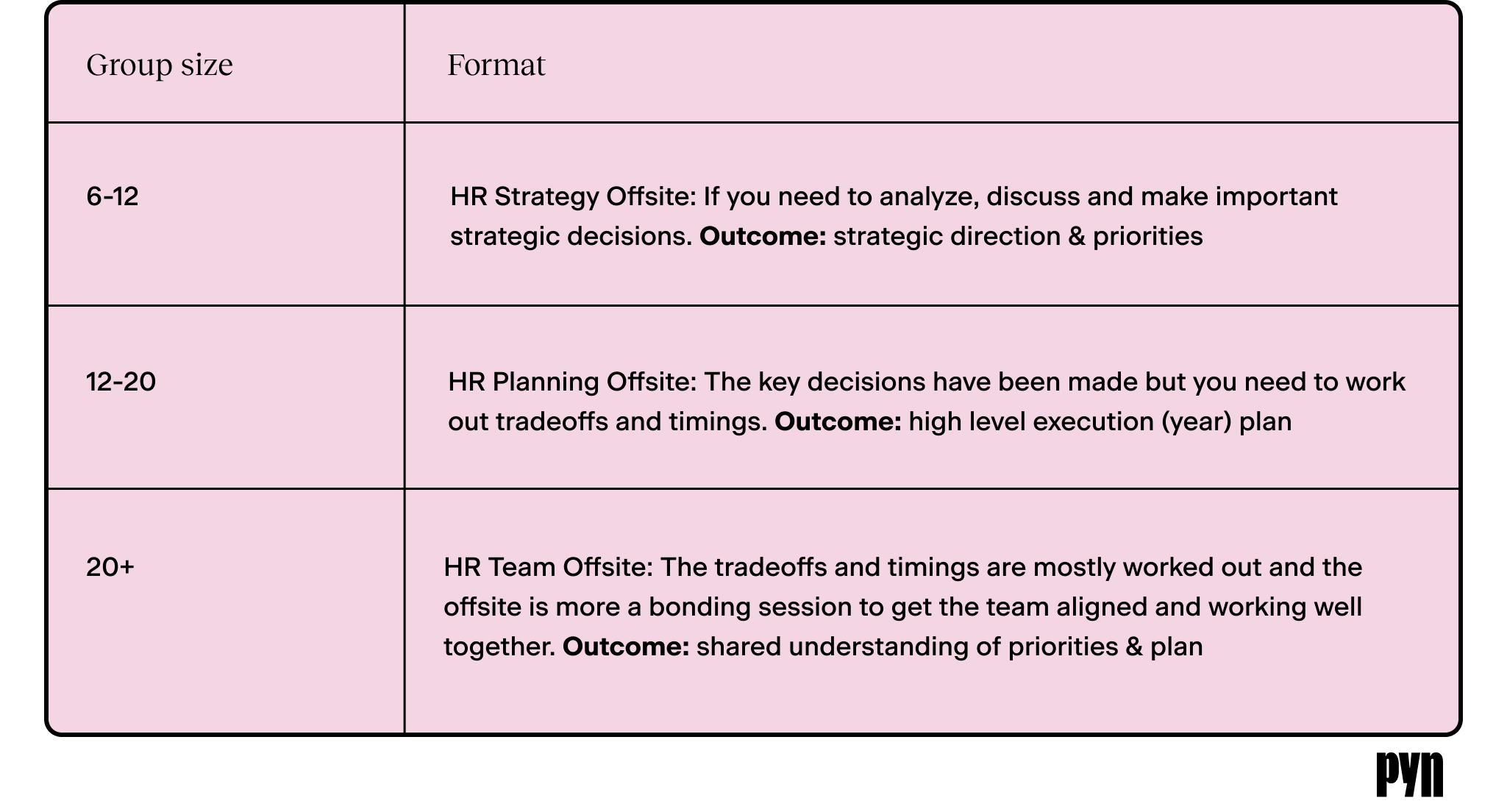
If your HR Team is larger, it may be best to invite the functional leaders first. Get them aligned in the Strategy Offsite. Then, once the core team is on the same page, engage the next level of your HR team around a Planning Offsite or Team Offsite.
In this post, I focus on the HR Strategy Offsite and cover some parts of the HR Planning Offsite. If you run your offsite over multiple days, you may be able to tackle both strategy formulation and planning parts.
2. How to plan for the desired outcomes
One common mistake is leaving planning decisions to the last few weeks prior to the offsite. Ensure you leave enough time to plan ahead
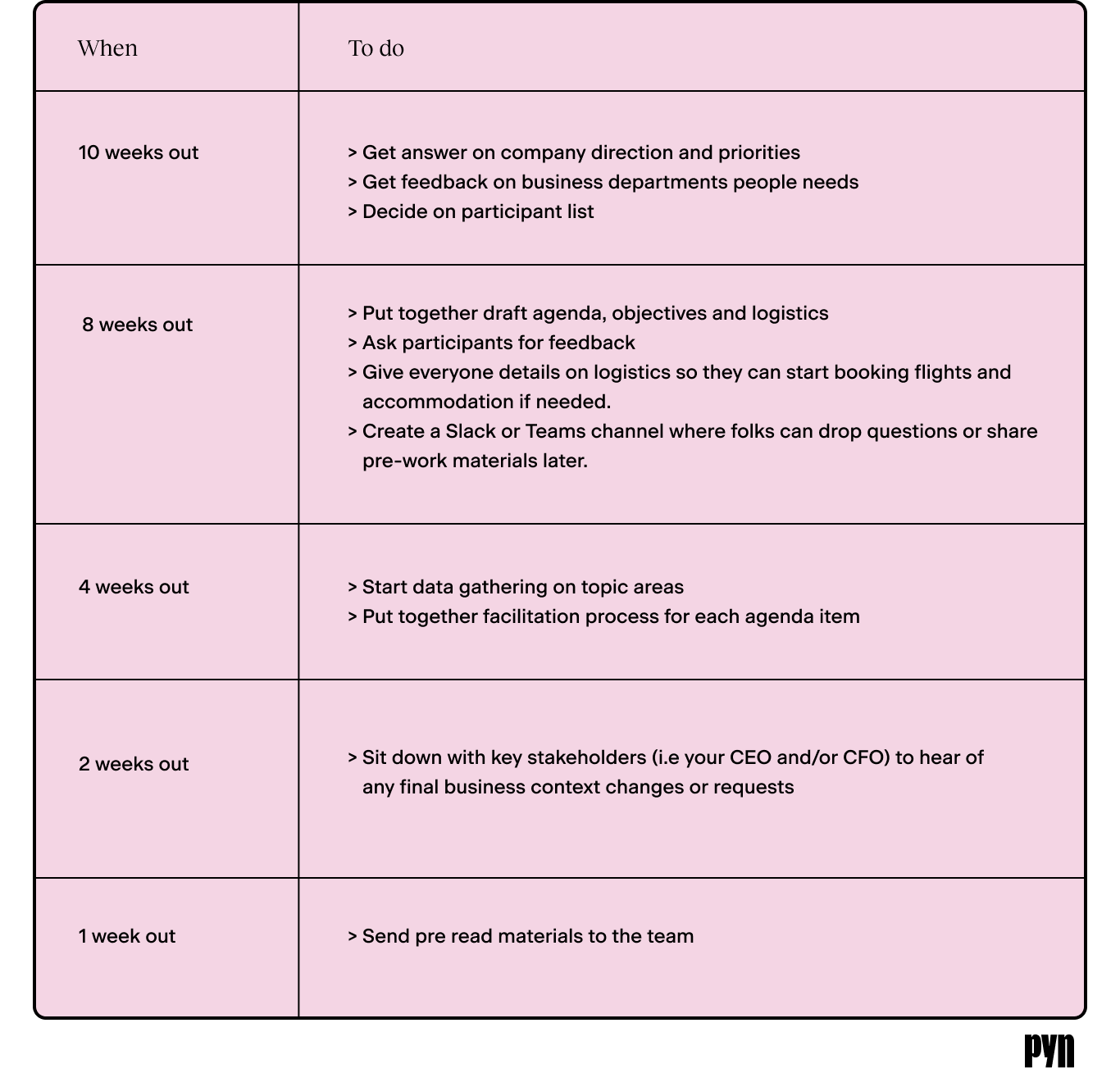
When planning, you need to know where in the strategy process you are. How much planning have other departments completed that will feed into your overall HR strategy? Do you need to address major challenges or topics first - or can you dive into prioritization? Or have priorities already been set and is this offsite really more about planning out the year?
The answers to such questions will determine your objectives and the type of offsite you want to hold.
3. Gathering the right context, assigning pre-work, and sharing data
Given our function in the company, it’s essential you really understand the context and needs of the business as well as doing pre-work on HR functional topics. Make sure you:
- Understand the macro context
- Understand the business context by asking your CEO questions
- Understand departmental needs by asking your department heads questions
- Ask functional leads to do pre-work on relevant HR functional topics you will cover
Understand the macro context
Given we live in turbulent economic times, you’d be taking into account how your company fares given those circumstances.
In a quick Pyn survey polling 300 HR practitioners, about 10% of respondents said their company is currently fighting survival. The type of strategy offsite will, of course, be heavily influenced by those macro circumstances.
Understand the business context
CEO questions: When planning your HR strategy offsite, it's important to get a sense of the company's priorities and business direction. One way to do this is by asking the CEO for their input.
Some questions you may want to ask include:
- What are the company's top priorities right now?
- What is the number one issue impeding the company right now? How can we solve it?
- What is the business outlook for the next year? (more specifically for Q4 2022: With the current economic climate, how will our business strategy change? (And how will this be communicated to the team)
- What changes do you anticipate in the workforce over the next few years?
- If you had 2 top priorities for the People function in the next 6 months, what would they be?
- Where is the People function adding the most value to the business (and where is it adding the least)?
- What key initiatives will the company take on next year, and can our current team execute them?
- What do you think is the strongest asset of our culture (and where do we fall down)?
All this will feed into the HR strategy and is invaluable in planning your strategy offsite.
Understand departmental needs
Department Heads questions: Similarly, you will want feedback and priorities from department heads. It won’t need to be long. Three questions you may ask are:
- What is your key priority next year (knowing what you know today)?
- How would you rate the HR team’s support last year (1 - 10 scale). Why?
- Where will you need the most HR support next year? Why?
Pre work through deep dives into topics
Instead of overloading folk with large numbers of articles, reports, etc - I found it much more constructive to have people compile functional and topic related data from inside the company (or examples from outside).
You’ll want to assign functional HR leaders any big topics you want to cover.
Take recruiting. Your CEO may have told you that they want headcount growth to be substantially more next year. You can ask your Head of Talent Acquisition to put together a detailed overview on the past year: how many people did we hire last year? What worked, what didn’t? What did other companies do?
The more thorough your prep work, the quicker your HR leadership team can dig in and make decisions.
Pre-work is generally distributed to participants beforehand - with a short time allotted during the offsite for Q&A based on the information.
4. The right HR offsite structure to compel progress
Once you are clear of the goals of the offsite, you can put together an agenda that leads you to those goals.
Generally, a strategy offsite contains at least the following:
- Reflections on the last year - what we did well and what could have gone better.
- Present and discuss a few key topics - likely around key challenges and opportunities
- Create a strategy plan for the year ahead
The right structure
Once you understand the business priorities (described in the section above) the most interesting planning begins:
- Selecting the high level topics to discuss; and
- Selecting the framework (the tools and facilitation process) that will help your HR the team identify the right strategic initiatives; and
- Devising a structured agenda which previews the outcomes for the meeting itself.
Like most HR leaders, I’ve been guilty of leaving large agenda items on various topics to be an open discussion. But experience shows that this rarely helps move the meeting forward.
I found a framework and a structured agenda is much more effective. Understanding the process in advance will move the discussions toward the ultimate goals. This HBR article on running offsites that aren’t a waste of time, suggests 45 minutes to two hours of discussion for each topic is enough for adequate conversation on a topic.
Your agenda may look something like this:
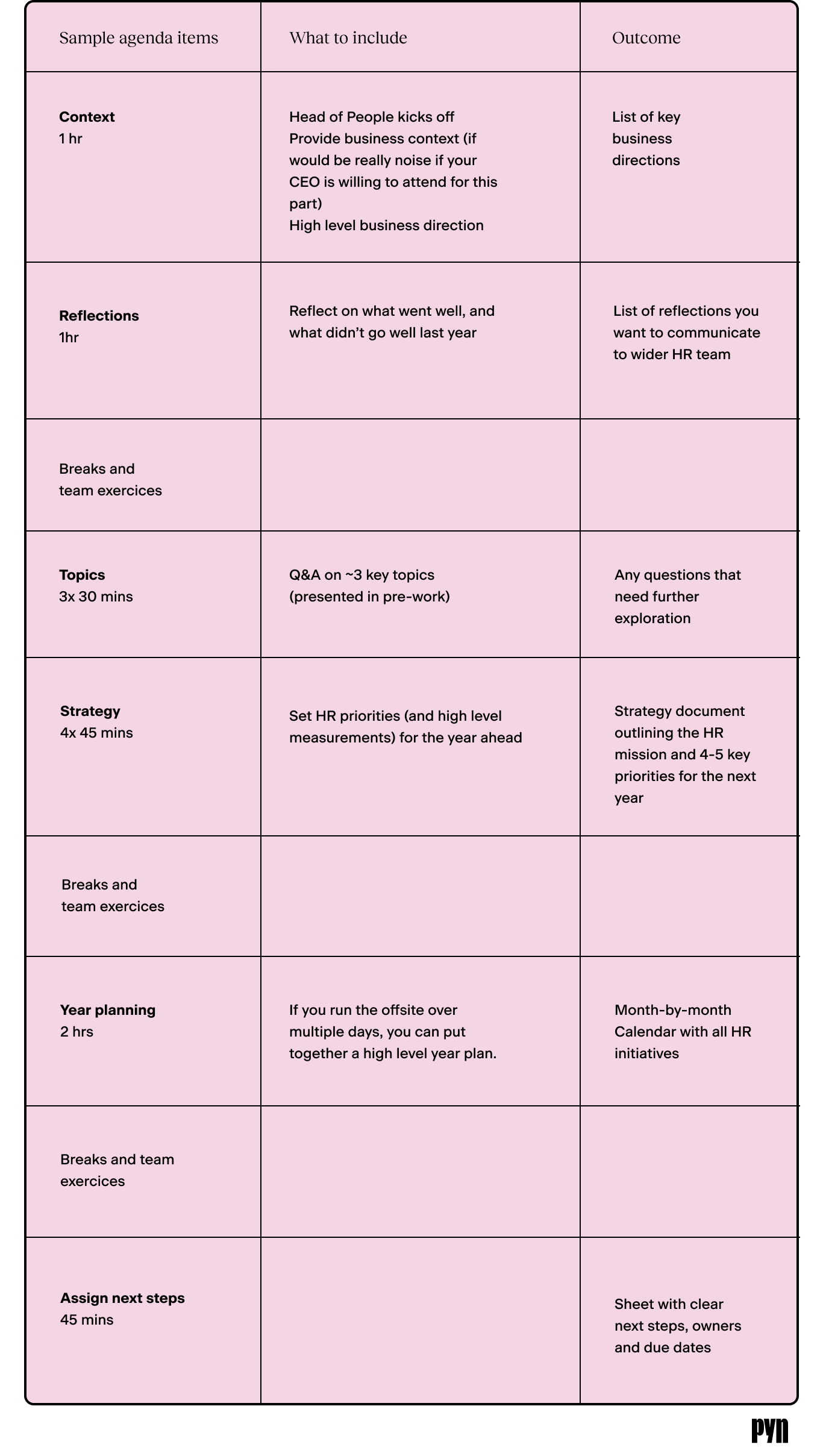
Tools and facilitation techniques to use
Take time well in advance of the event to prepare any presentations or handouts for each agenda item you’ve mapped out and any templates, tools, and facilitation techniques you wish to use.
There are plenty of tools or facilitation techniques you may decide to facilitate your HR leaders towards the right decision. I’ll describe three that have helped me in the past.
Do you have a great facilitation technique you want to share? Something that helped you to design your HR strategy in the past? Please send a note to hello@pynhq.com, and I'll add it when I update this post!
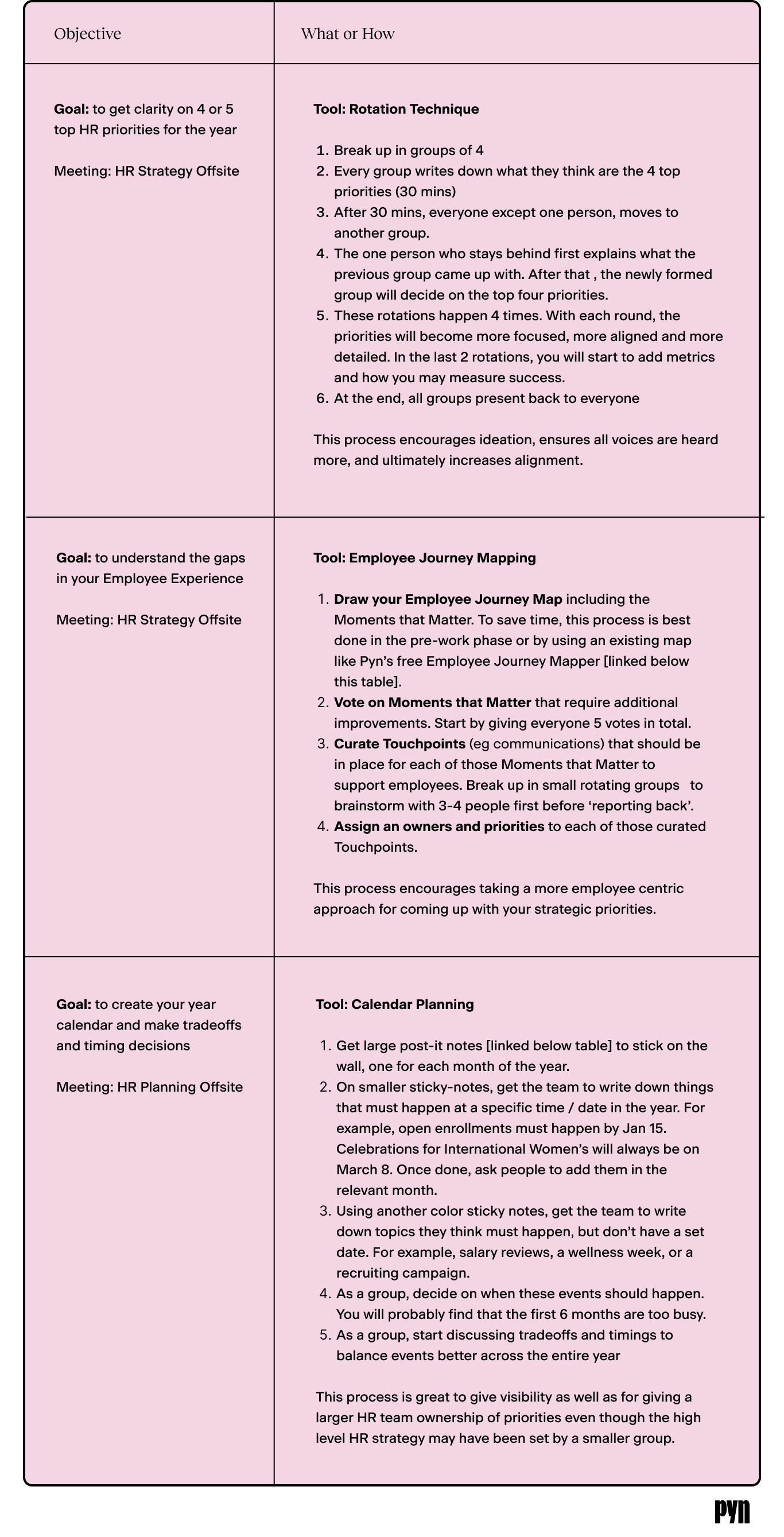
Linked resources from table:
5. On the day(s) of your offsite
Your offsite is finally here! You are all gathered in the offsite space, you and your team have done their homework, and everyone is excited to start! Below, I cover some suggestions to ensure the day runs smoothly and everyone knows what is expected.
Show samples of the end-result first
By showing a visual (sample of) the outcome first, will help people visualize what they are working towards.
For example, if you are working to identify your most critical priorities for the next year to instill focus and discipline for the biggest impact, you can start by showing the team a template.
Like these two samples of Strategy Templates below:
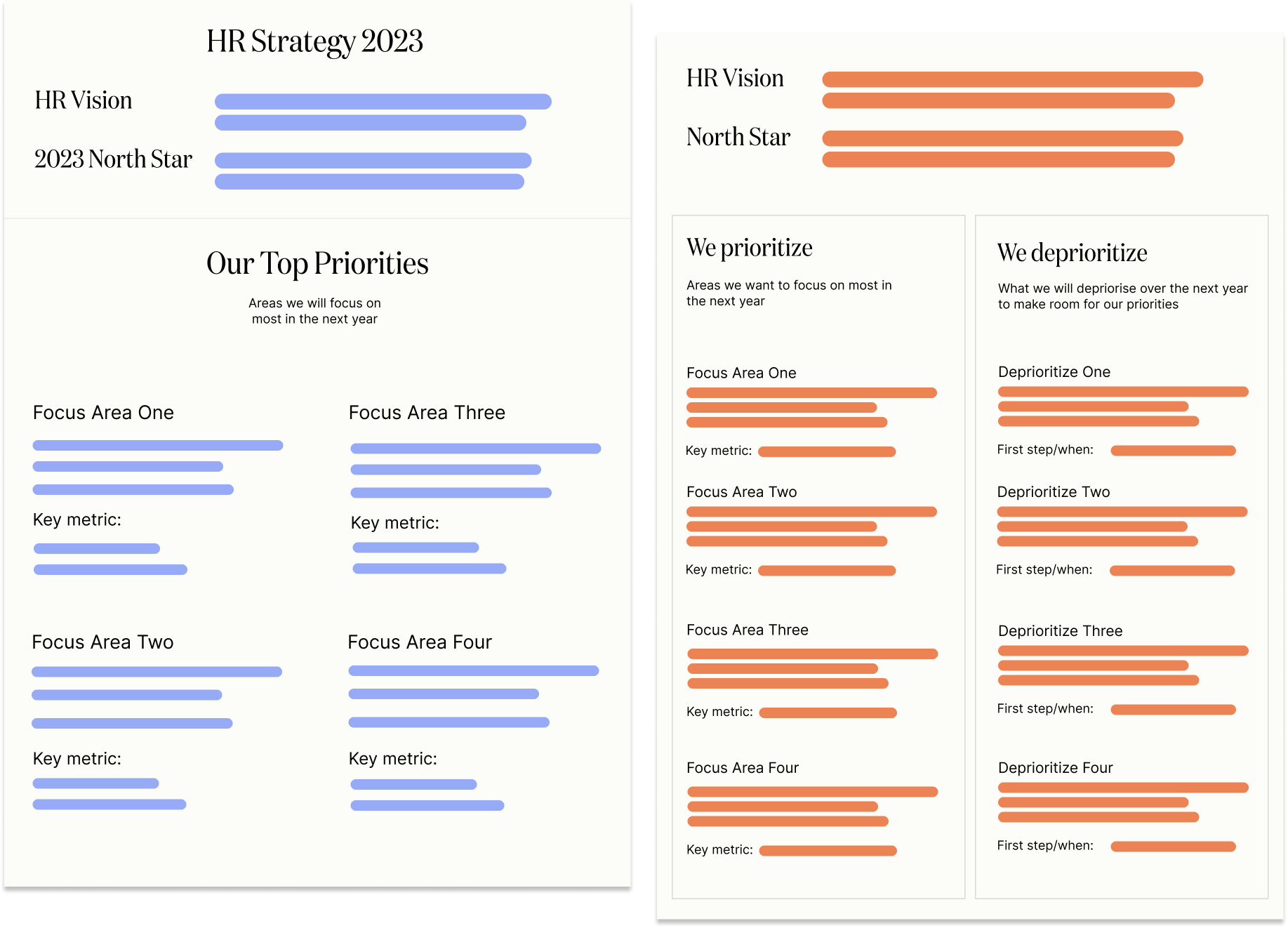
Do you have a great HR Strategy Template you want to share? Something that helped you to design your HR strategy in the past? Please send a note to hello@pynhq.com and we can reference you when I update this post!
After people understand the end-goal, you can run the group through the process/facilitation to get to that desired outcome.
Keep your team focused and on track
During the introduction, make it clear to everyone that part of this offsite’s success is dependent on the participants staying on topic. Otherwise you’ll risk ending up with a long list of unrelated action items and no cohesive strategy.
Have a parking-lot sheet
A side conversation or an interesting, but not related, idea can derail your entire conversation. At the same time, important comments and ideas will come up which deserve follow up.
Do yourself a favor and hang up a big sheet of paper with “a parking lot”, or a space to leave comments, discussions or questions that are not related to the current meeting's agenda. You can also use it to record topics that you don't have time to cover in the current meeting. Ensure you follow up on the topics in a later meeting.
Icebreakers, team bonding, and context setting
Team collaboration (Video)
- Let participants watch the whole video,
- summarize the 5 dysfunctions at the end.
- Break the group up in smaller groups and assign them 2 of the dysfuctions each
- Ask them to provide an example/story from within the team or company that represents their two assigned dysfunctions
- Report the examples/stories back to the team
Prioritization (Video)
An exercise for larger groups with different seniority levels and different experiences with planning.
- Let participants watch the whole video,
- Ask for feedback on the video after
The video is old, and old-fashioned, which may make you smile (and cringe) a bit. But the concept gets people into the right frame of mind.
Icebreakers
- Get a pack of cards/questions like this and go around the room asking people to answer questions.
- Preferably everyone feels comfortable answering any question - but give people the option to skip a card if the question doesn’t resonate or doesn’t feel right for them.
Tips for those who run their offsite fully remote
I'd strongly encourage you to try and get your HR leadership team together face-to-face. Especially if you normally don't work from the same location, this is a great opportunity to get some face-time!
But, sometimes, it's just not possible. Here's some tips I found very helpful to ensure the remote offsite runs well.
- Shorten the days as we all know that folks will loose attention and concentration if they stare at the screen for too many hours. It means that you'll probably need to spread your offsite over more days.
- Get people off their chair by building in breaks or short "walk & talk" sessions. If you set a break, people may use that time to catch up on a quick email (also at their desk), so instead give people an assignment that prompts them to get up.
- Use tools like Miro or Figjam to make it easier for everyone to participate at the same time.
- Use breakout rooms available in tools like Zoom. To avoid group-think and encourage ideation it is best to break out and present back instead of discussing every topic together.
- Set remote-friendly ground-rules. Ensure folks are reminded of ground rules around muting, raising hands, returning in time from breaks, etc.
6. Wrapping up the day and follow-up
When you get to the end of the offsite, there are a few things to do in order to wrap-up and have clear communications post-offsite.
Assign owners and next steps for each outcome
Don’t leave the room without clear owners and next steps.
You should have a list of outstanding tasks, each with a task owner, a due date, and an agreement on how the actions are communicated back to the group.
Decide on the day and time of follow up meetings
It’s likely that you will have a number of check-in meetings after the offsite, and take a few minutes to add those into people’s calendars before people leave for the day. This is the first time people can open their phones or laptops.
Send a follow-up message
Not only is it nice to thank everyone for joining and for their input, it is also a great opportunity for you to reinforce the key offsite outcomes and next steps.
If you add your follow-up in a messaging app like Slack or Team or on a wiki like Notion or Confluence - it is easy to @mention specific people and keep the conversation going.
Ask for feedback
You’ll likely be organizing another offsite next year. So, while it’s still fresh in people’s heads., Don’t miss out on the opportunity to ask for feedback that you can incorporate in your next event.
Some sample questions to ask:
- Overall, how productive was the Offsite (1-5 scale). Why?
- How comfortable did you feel sharing your opinions (1-5 scale). Why?
- What session did you find most useful? (show agenda)
- What session did you find least useful? (show agenda)
- What was missing from the offsite or the pre-work?
- What feedback do you have about the offsite location and overall logistics?
- Do you have any other suggestions or feedback?

Joris dreamt of having Pyn as Head of People at Atlassian and Squarespace. Now dreams of getting a sleep-in on Sunday.
